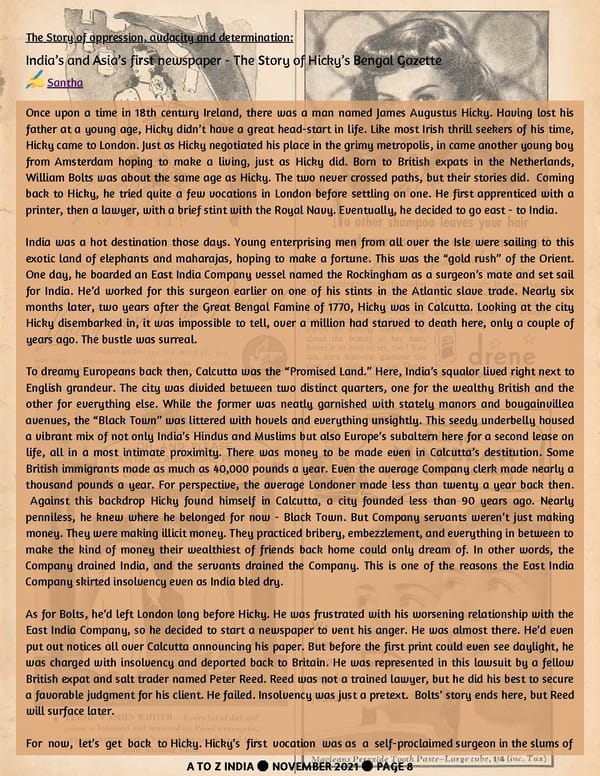The Story of oppression, audacity and determination: India’s and Asia’s first newspaper - The Story of Hicky’s Bengal Gazette Santha Once upon a time in 18th century Ireland, there was a man named James Augustus Hicky. Having lost his father at a young age, Hicky didn’t have a great head-start in life. Like most Irish thrill seekers of his time, Hicky came to London. Just as Hicky negotiated his place in the grimy metropolis, in came another young boy from Amsterdam hoping to make a living, just as Hicky did. Born to British expats in the Netherlands, William Bolts was about the same age as Hicky. The two never crossed paths, but their stories did. Coming back to Hicky, he tried quite a few vocations in London before settling on one. He first apprenticed with a printer, then a lawyer, with a brief stint with the Royal Navy. Eventually, he decided to go east - to India. India was a hot destination those days. Young enterprising men from all over the Isle were sailing to this exotic land of elephants and maharajas, hoping to make a fortune. This was the “gold rush” of the Orient. One day, he boarded an East India Company vessel named the Rockingham as a surgeon’s mate and set sail for India. He’d worked for this surgeon earlier on one of his stints in the Atlantic slave trade. Nearly six months later, two years after the Great Bengal Famine of 1770, Hicky was in Calcutta. Looking at the city Hicky disembarked in, it was impossible to tell, over a million had starved to death here, only a couple of years ago. The bustle was surreal. To dreamy Europeans back then, Calcutta was the “Promised Land.” Here, India’s squalor lived right next to English grandeur. The city was divided between two distinct quarters, one for the wealthy British and the other for everything else. While the former was neatly garnished with stately manors and bougainvillea avenues, the “Black Town” was littered with hovels and everything unsightly. This seedy underbelly housed a vibrant mix of not only India’s Hindus and Muslims but also Europe’s subaltern here for a second lease on life, all in a most intimate proximity. There was money to be made even in Calcutta’s destitution. Some British immigrants made as much as 40,000 pounds a year. Even the average Company clerk made nearly a thousand pounds a year. For perspective, the average Londoner made less than twenty a year back then. Against this backdrop Hicky found himself in Calcutta, a city founded less than 90 years ago. Nearly penniless, he knew where he belonged for now - Black Town. But Company servants weren’t just making money. They were making illicit money. They practiced bribery, embezzlement, and everything in between to make the kind of money their wealthiest of friends back home could only dream of. In other words, the Company drained India, and the servants drained the Company. This is one of the reasons the East India Company skirted insolvency even as India bled dry. As for Bolts, he’d left London long before Hicky. He was frustrated with his worsening relationship with the East India Company, so he decided to start a newspaper to vent his anger. He was almost there. He’d even put out notices all over Calcutta announcing his paper. But before the first print could even see daylight, he was charged with insolvency and deported back to Britain. He was represented in this lawsuit by a fellow British expat and salt trader named Peter Reed. Reed was not a trained lawyer, but he did his best to secure a favorable judgment for his client. He failed. Insolvency was just a pretext. Bolts’ story ends here, but Reed will surface later. For now, let’s get back to Hicky. Hicky’s first vocation was as a self-proclaimed surgeon in the slums of A TO Z INDIA ● NOVEMBER 2021 ● PAGE 8
 A TO Z INDIA - NOVEMBER 21 Page 7 Page 9
A TO Z INDIA - NOVEMBER 21 Page 7 Page 9